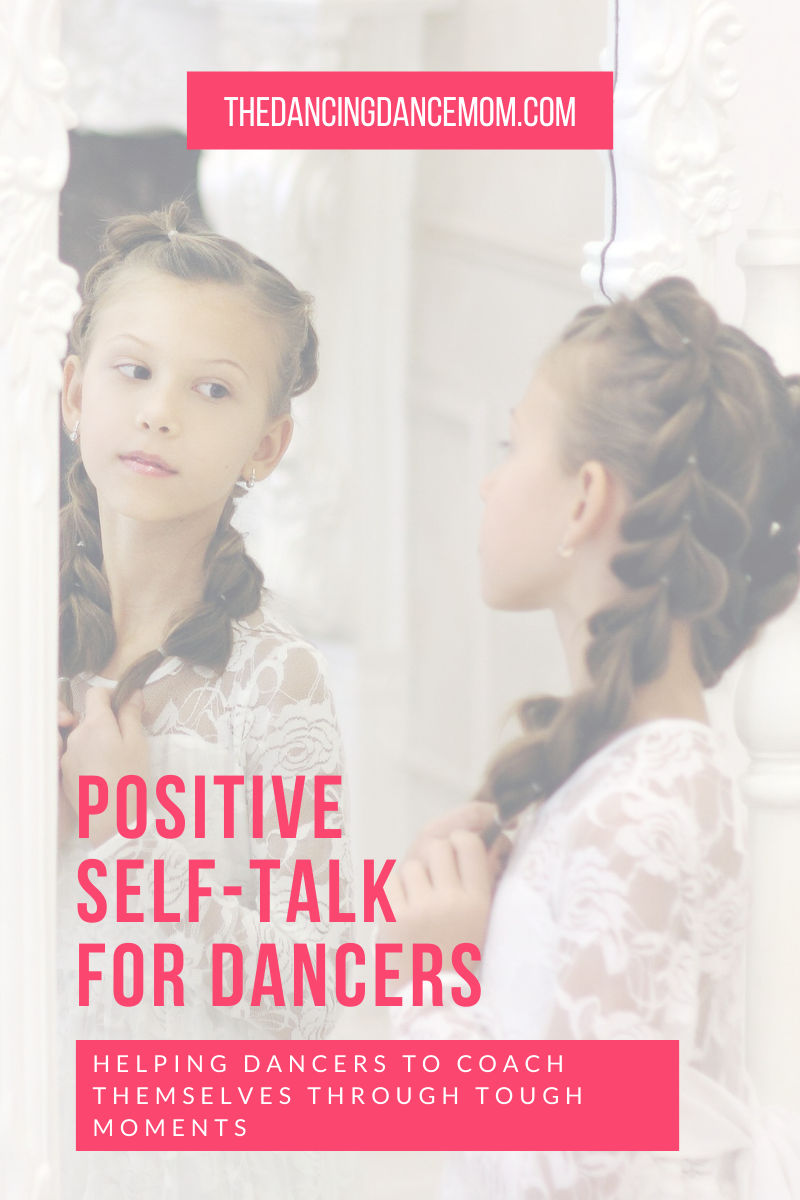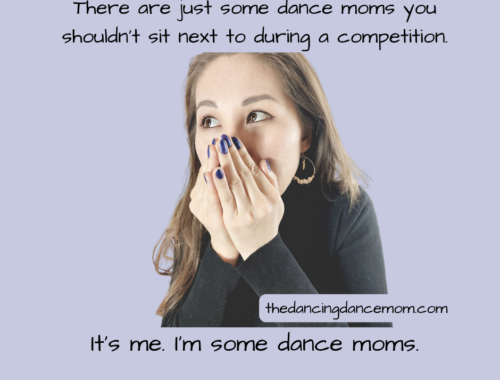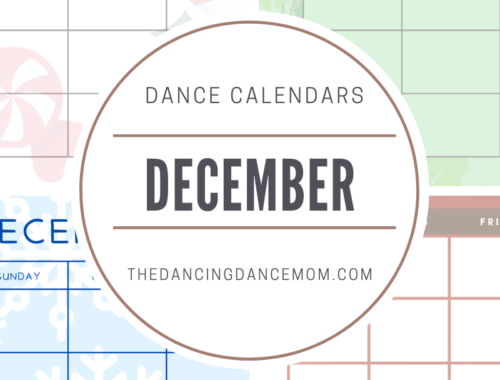
Positive Self-Talk for Dancers
For decades, my role in education was that of a reading interventionist. For 15 years, I serviced middle school students that struggled to keep up with their peers in all areas of literacy. I was fairly successful with diagnosing and targeting specific skill deficiencies. But after awhile, I realized that my struggling learners were having difficulties beyond their reading and writing woes. Specifically, they lacked resilience – the willingness to work through their challenges that their higher-performing classmates seemed to have. Typically, they would simply give up whenever they faced a roadblock.
This past school year, I took on the role of a social-emotional learning teacher. My course focuses on goal-setting, growth mindsets, overcoming roadblocks, managing emotions, resolving conflicts, and more. These are the essential “soft skills” that so many of us lack. So I was thrilled to assume the role of Teacher of Psychology to help preteens navigate the choppy waters of adolescence. Most of all, I wanted to help them build resilience.
As I began to teach the key concepts of the course, I realized how highly relevant these lessons could be to young athletes. Because our family is deeply immersed in the dance, soccer, and wrestling worlds, I started to notice the connections my own kids could make to the very same lessons I was teaching in the classroom. Since my dancing daughters are more willing to listen to their mom with an open mind (as opposed to my nearly-grown son), I decided to start with them. Helping them build their own levels of resilience seemed like a great place to start.
In Their Own Heads
Both of my girls have solos, and they also have a duo together. At some time or another, each girl has experienced an episode of severe self-doubt shortly before taking the stage. As I’ve tried to talk them off the ledge for the first few years, I could see signs that they were tuning me out because they were too “in their own heads.” Sometimes, their teachers were not around to help them work through the anxiety (and even calming words from their identical twin did no good). I felt powerless as I watched them psych themselves out, and their fear usually showed in their performance.
I realized that I needed to teach them the same idea that I now teach my middle school students: As you grow up, you may come to realize that the only person you can truly count on is yourself. Now I tell my kids and my students that they have to become their own cheerleaders or coaches to get themselves through tough times. To do this, they can harness the power of positive self-talk.
Straight Talk About Positive Self-Talk
According to verywellfamily.com: “At its core, positive self-talk is a coping mechanism that empowers kids to reframe their thinking, nurtures resilience, and builds self-esteem.” If your child practices positive self-talk, they can “coach” themselves through a rough patch. This way, they don’t have to rely on someone else to pick up their spirits).
Children (and adults!) who regularly use positive self-talk enjoy these benefits and more:
- building resiliency
- developing a positive outlook on life
- helping to identify strengths
- instilling self-confidence
- pushing us to seek out things we are good at
- allowing us to recognize areas of improvement
- empowering us to face challenges and take risks
- providing us with courage to go after dreams and set goals
- improving problem-solving
- facilitating better decision-making under stress
So How Do You Do It?
When our kids face a difficult situation that might evoke a negative emotion (fear, anxiety, anger, etc.), they can train themselves to recognize and “catch” the thought before it spirals out of control. Then they can develop the habit of coaching themselves through the moment by having a few encouraging thoughts ready.
Standard phrases like “I got this” or “I will give it my best shot” work well enough in some situations. But they might not resonate with your child in an emotionally-charged moment, and may come across as too generic or vague. For their inner voices to truly rise above the buzz of their misgivings, they should engage in self-talk that is more specific to the situation and/or themselves.
While this is easier said than done, kids can prepare a handful of ready-to-go phrases by answering these questions.
How Have I Prepared For This?
Pausing to take inventory of all the time and effort your dancer put into getting ready for a big moment can help them feel more prepared, inspiring the confidence necessary to push through their doubts. For example:
- “I’ve rehearsed this number for six months, so I know the choreography inside and out.”
- “Since January, I worked with Miss Jenny on that correction. I trust myself to execute it on stage.”
- “I listened to and wrote down all of my critiques, and have been making sure to address them during each rehearsal.”
- “My ballet training has improved my technique, so my body knows what to do.”
What Are Some of My Accomplishments?
Dancers can bolster their confidence by remembering how far they’ve come. Acknowledging one’s progress is a powerful strategy; it helps to remind us that we’re further along than we may have thought possible in the past.
- “I didn’t think I could master my double pirouette, but I have that 100% now. I can ‘get’ this new skill, too.”
- “Miss Laura said that I have stopped sickling my feet, so I’ve shown that I can apply corrections.”
- “I got called out in tap class at the last convention, so I must have been doing something right!”
- “I have solved bigger problems than this; so I am capable of handling this situation.”
What Has Gone Well?
Sometimes, your dancer can adopt a more positive mindset just by focusing on what has gone right (that day, that week, previously in the dance year – any timeframe works). It could even be something small or simple! Here are some examples:
- “I got up on time this morning.”
- “I remembered to pack all of my costumes and accessories.”
- “Our group dances went well this morning, so I believe my solo will be great too!”
- “My friends and I had fun during our lunch break.”
What Am I Thankful For?
Humans are programmed to detect threats, so we naturally look for the negatives in our environment. The habit of practicing gratitude is becoming more well-recognized as a calming, “grounding” strategy; it refocuses our attention on the positive aspects of our lives. Some examples of positive self-talk that are born of gratitude can be:
- “I’m so happy that my grandparents came to see me today!”
- “No matter what happens, my parents will be there to support me.”
- “I’m looking forward to cuddling with my pet when I get home! That always makes me feel better; I’m so thankful I have her.”
- “My dance teacher will help me to improve for my next performance if things don’t go exactly as planned today. I appreciate her cheering me on and helping me to grow.”
These are just a sampling of categories your dancer can use to generate positive self-talk statements. The possibilities are endless!
Slow and Steady
If you introduce the practice of positive self-talk to your child, don’t be surprised if they’re not overly enthusiastic about it at first. Focus more on developing the habit gradually so that your child doesn’t feel like it’s a new burden they must bear.
You might want to start just by introducing the concept in a casual conversation, describing how it can be helpful in a simple, age-appropriate way. Don’t introduce the idea in a high-pressure situation (we generally aren’t receptive to new ideas during highly emotional episodes). Instead, save it for a time when you’re driving them somewhere (and they’re a captive audience) or during some downtime at home. Just make sure the atmosphere is relaxed and calm.
Role Model
From there, you can model your own use of positive self-talk. While it may seem a little silly at first, your child probably won’t buy into the idea if they feel you haven’t! Demonstrate how to do it by simply repeating one of the phrases you’ve created for yourself.
For example, let’s pretend that you’ve forgotten your work laptop at home. Coach yourself aloud, saying something like, “I am usually very organized, so this was just a minor slip-up. I can ask for a loaner or use my desktop instead.” Such a statement acknowledges a positive character trait (organization) while giving yourself a bit of forgiveness (“just a minor slip-up”). The last sentence demonstrates a problem-solving strategy that helps to remedy the situation.
Be mindful of avoiding the temptation to insult yourself (“I’m so stupid!”); kids internalize these moments, and may fall victim to destructive thoughts themselves if they see their grown-ups doing it.
Going forward, seek out opportunities for your child to use positive self-talk. Start with low-stakes situations, and make gentle suggestions of what they can say to themselves. Even if they seem like they’re dismissing the strategy, be persistent without being pushy. You may be happily surprised one day to see them coach themselves through a rough patch.
Work in Progress
When Thing 2 was experiencing some anxiety before a solo performance this year, I could see that she was completely tuning me out. I gently took her by her shoulders and said, “You’ve got to get yourself through this. You know what to say to yourself and you know what to do. I have complete faith in you.” Rather than arguing with me (which she had been doing), she took a deep breath and walked away. I saw her sit down, put her head in her hands, and work to regulate her breathing and calm herself down. She was significantly more composed by the time she took the stage (she scored in the top 10 out of 60+, if you’re wondering).
The next day, I asked her what she thought to herself to get her through that rough patch. She said that she reminded herself of how much she loves this solo, and of the scholarships and awards she had already earned this year.
For me, this affirmed the idea that, even though it often doesn’t seem like it, our kids DO listen to us. Keeping an open mind to the power of positive self-talk can help your dancer be their own best coach and cheerleader. As they grow into adulthood, we want them to know that they can always rely on themselves when the going gets tough.
Having goals helps us all reach that next level, but are your child’s goals reachable? Check out SMART Goals for Dancers for tips on how to create smart, measurable, attainable, relevant, and time-bound goals!
You May Also Like

It’s Me. I’m Some Dance Moms.
June 18, 2022
Dandy December Dance Calendars
November 15, 2022



3 Comments
Megan
I love the idea of visiting past accomplishments. What a great confidence boost that would be, to know you’ve conquered something challenging!
Lisa, Casey. Barrett Dog
Having goals is always great! It helps us push ourselves more and more. Visiting those past accomplishments are also good.
Cindy
Excellent suggestions for all athletes and everyone really! Developing positive self talk is a valuable tool throughout life.